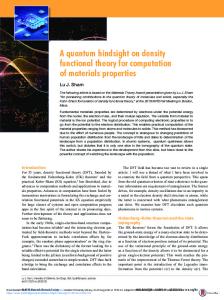Orbital-free density functional theory for materials research
- PDF / 401,250 Bytes
- 19 Pages / 584.957 x 782.986 pts Page_size
- 41 Downloads / 530 Views
Orbital-free density functional theory for materials research William C. Witt, Beatriz G. del Rio, and Johannes M. Dieterich Department of Mechanical and Aerospace Engineering, Princeton University, Princeton, New Jersey 08544-5263, USA
Emily A. Cartera) School of Engineering and Applied Science, Princeton University, Princeton, New Jersey 08544-5263, USA (Received 28 September 2017; accepted 27 November 2017)
Orbital-free density functional theory (OFDFT) is both grounded in quantum physics and suitable for direct simulation of thousands of atoms. This article describes the application of OFDFT for materials research over roughly the past two decades, highlighting computational studies that would have been impractical (or impossible) to perform with other techniques. In particular, we review the growing body of simulations of solids and liquids that have been conducted with planewave-pseudopotential (or related) techniques. We also provide an updated account of the fundamentals of OFDFT, emphasizing aspects—such as nonlocal density functionals for computing the kinetic energy of noninteracting electrons—that enabled much of the application work. The article concludes with a discussion of the OFDFT frontier, which contains brief descriptions of other topics at the forefront of OFDFT research.
I. INTRODUCTION
Some of the most challenging problems in materials science—and many ordinary ones too—require a theory and computing strategy that is grounded in quantum physics and suitable for simultaneous study of thousands of atoms. Crystalline alloys with motifs of tens or hundreds of atoms are one straightforward example; for these solids, supercells of several repeated unit cells can quickly cross the thousand-atom threshold. Dislocations in metals are another example; these defects are characterized both by local disruptions in periodicity and by a long-ranged elastic strain field that can interact with other dislocations or grain boundaries. Finally, it is well known that ab initio molecular dynamics (MD) simulations are useful for probing the structure of liquids but only if a sufficient number of atoms are included to prevent spurious correlations. Orbital-free (OF)1–4 density functional theory (DFT),5–7 rooted in quantum mechanics, is an especially promising tool for the materials community. Its principal advantages over standard Kohn–Sham (KS)8 DFT are speed and computational scaling: as the number of atoms in a simulation increases, the computational effort required for OFDFT can be made to scale linearly [or quasi-linearly, O(N log N)] with a small prefactor. The chief aim of this
Contributing Editor: Steven D. Kenny a) Address all correspondence to this author. e-mail: [email protected] DOI: 10.1557/jmr.2017.462
article is to review the application of OFDFT for materials research over roughly the past two decades, highlighting examples where OFDFT was, and remains, perhaps the only tool available. Before doing so, we give an updated overview of the fundamentals, emphasizing the aspects of the theory that en
Data Loading...











